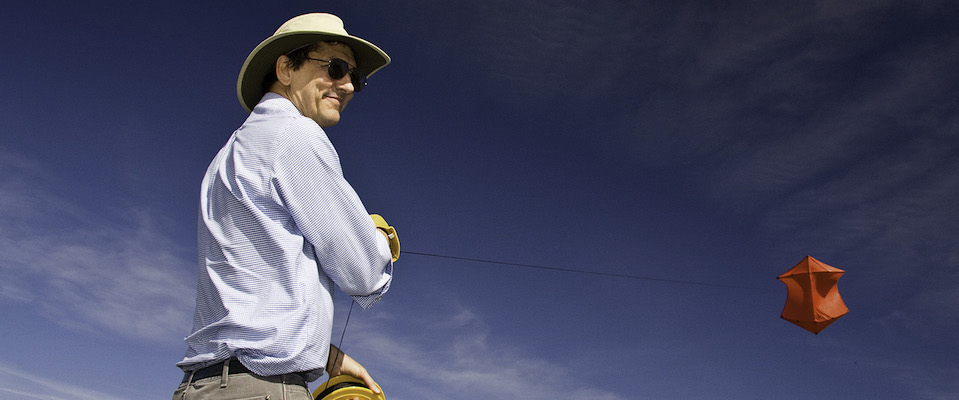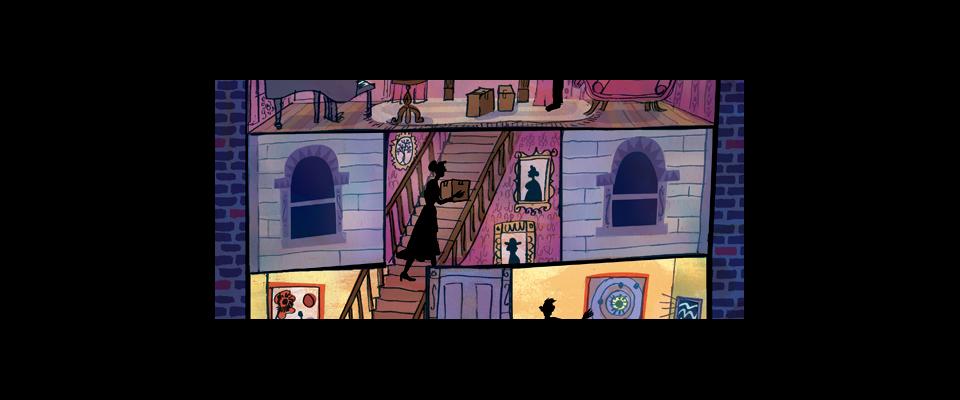Drone use has taken off in recent years for landscape and environmental photography, and it has photo-enthusiasts aflutter with the question: Will drones knock kite aerial photography (KAP) off the map? For Charles Benton, a UC Berkeley architecture professor known for making KAP into a well-respected (if niche) art form, the answer is: nah.
“For my purposes kites are a much better lifting mechanism for still photography,” Benton says. And he would know, having already chosen kites over the alternatives years ago.
Benton got into radio-controlled model fliers eight years before getting into KAP, taking up sailplanes not long after he joined the Berkeley faculty in 1984. It was his sailplane adventures at Cesar Chavez Park that led him to meet a group of kite builders—and so began a very accomplished history. Highlights over the years include his groundbreaking photography of the South Bay salt ponds, a sabbatical spent as Artist in Residence at the Exploratorium, and other residencies at the Atlantic Center for the Arts and the Headland Center for the Arts.

In case you’re not familiar with it, here’s an overview of KAP: photographers attach radio-controlled cameras to kites, fly them into the air, and capture low-level aerial photographs. Drones, sometimes known as “quadcopters,” generally come with a camera and are battery operated, so drone photography is much less makeshift.
So what makes KAP better than drones when it comes to still photography?
For starters, quadcopter flight times are limited, says Benton, whereas his kites often keep cameras in the air for 2 to 3 hours. Also, most consumer multirotors—helicopters having more than two rotors—only lift small GoPro-scale cameras. But Benton uses an APS-C sensor with interchangeable lenses, which would require a multirotor costing upwards of $10,000.
Another negative of drones is that they require the operator to shift focus away from photography and more to technical aspects of keeping the drone in the air, which Benton says he’s not fond of.
And then, of course—there’s the issue of where drones are even allowed to roam. The Baylands Conservation Committee notes in a 2015 report that park users and wildlife both find drone noise “very disruptive,” and there are concerns about inexperienced drone operators posing a threat to safety—so more drone regulation is in the works. Benton’s work in the Don Edwards National Wildlife Refuge and the Golden Gate National Recreation Area occurs in jurisdictions where drones are totally banned, so KAP offers a strong advantage.
Another negative of drones is that they require the operator to shift focus away from photography and more to technical aspects of keeping the drone in the air, which Benton says he’s not fond of.
One way that Benton measures a successful day in the field is by assessing the ratio of time spent thinking about the kites to time spent thinking about photography. Benton sews his kites to be very stable, so in good conditions, they practically fly themselves—allowing him to have what he calls “a 10% [platform] to 90% [photography] ratio.” But if the wind is unsteady or the landscape provides obstacles (like trees), the ratio can drop to 50:50.
With quadcopters, Benton says, he’d be spending a lot of cognitive overhead focusing on battery status and drone location—making the 10:90 ratio “virtually impossible to achieve.”

Of course, Benton acknowledges that there are benefits to using drones. They have brushless gimbals (devices that keep the camera steady)—which provide less shaky results than the cheaper servo gimbals—and that’s great for GoPro-quality video. And, unlike kites, drones can go upwind and fly when wind is calm.
There’s also the issue of each kite having a certain range, and flying out of that range can lead to what Benton calls “the heartbreak of instability,” which is one reason why experienced KAPpers bring different kites to the scene they want to shoot. When Benton returns from a day of shooting and his wife asks how it went, if he tells her it was a “one kite day” that means he selected the perfect kite from his quiver of eight and the job was done. On a “five kite day,” however, the wind was unstable and he spent a lot of time fiddling.
Despite all this, Benton says the general annoyance that drones produce in public spaces—as well as problems with rogue fliers and issues of safety and privacy—make kites a better option.
And what appears to be the major drawback of using drones, according to Benton and others on KAP message boards, is that the artistic process suffers.
“KAP appeals to that part of me, perhaps of all of us, that would slip earthly bonds and see the world from new heights,” Benton says.
Benton enjoys the invention aspect of KAP—he spends many hours at a workbench building camera cradles, control devices and other electronics from scratch, and on his 1938 Singer Featherweight sewing kites. KAP also requires a learned proficiency in the art of kite flying, which can be difficult, but rewarding.
Also, for Benton, KAP is a multi-faceted experience that’s not just technical, but contemplative.
“KAP appeals to that part of me, perhaps of all of us, that would slip earthly bonds and see the world from new heights,” Benton says. “Its aerial views offer a fresh perspective of familiar landscapes and in doing so challenge my spatial sensibilities, my grasp of relationships. The technique resonates with my sustained fascination with photography’s capacity to reveal patterns and phenomena that lie beyond the capacities of our native senses.”
He compares this to Edward Muybridge’s work photographing human and animal movement undetectable by the human eye, as well as the Eameses’ famous short film Powers of Ten, which investigates the relative size and significance of scale by plunging into the Earth and back out again.

Benton also revels in the intellectual process of what he calls “interrogating the landscape.” While he has rigs and an electronic viewfinder that would allow him to see what the camera is shooting while in the air, he never uses them, preferring to guess what the camera is seeing from above to test his personal perception.
“When I later compare my mental image of the landscape—my visual hypothesis—to the photograph captured, there are invariably differences that warrant reflection and an adjustment of my sense of the place,” Benton says. “In the end, kite aerial photography allows me to be overtly rational in the technology and scientific understanding required to capture the images, while simultaneously embracing chance and happenstance. The images thus created are entertaining negotiations between technical prowess and the vagaries of nature.”





















